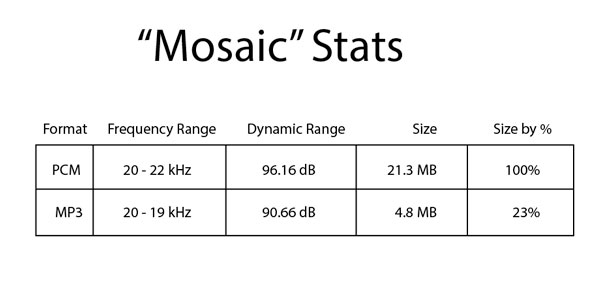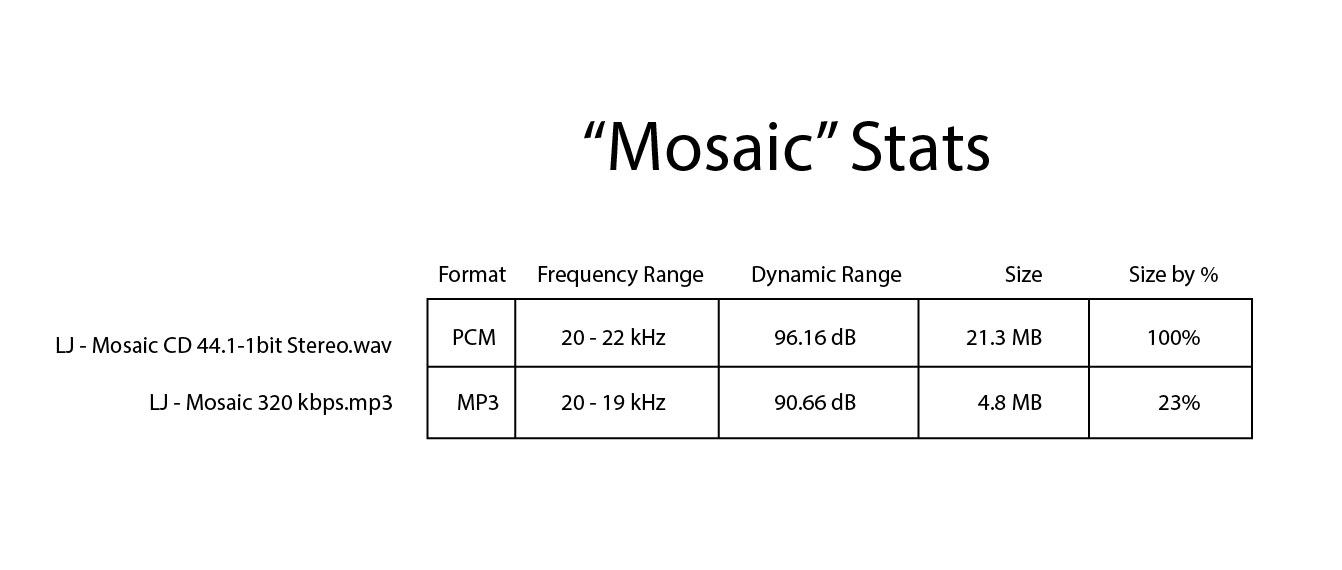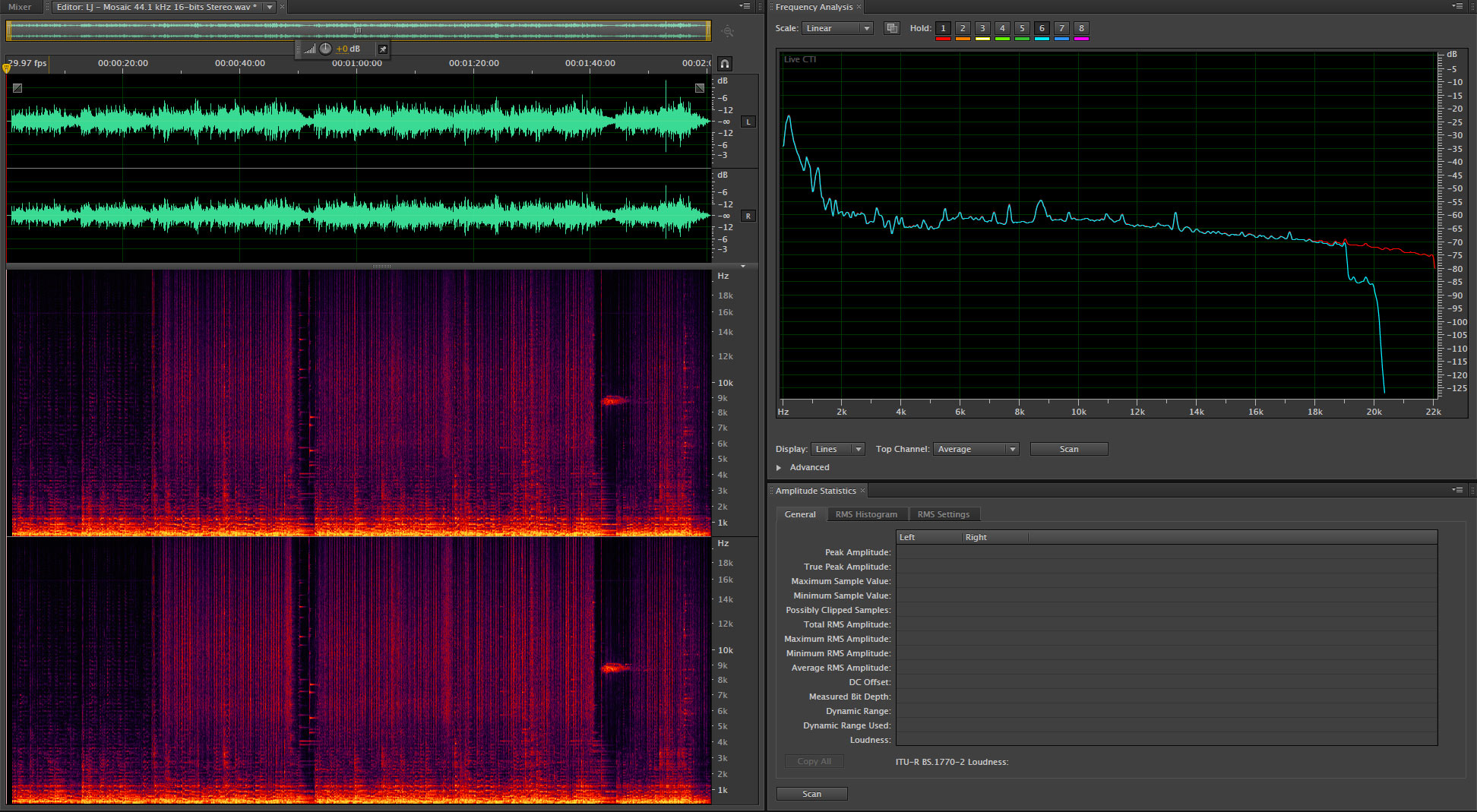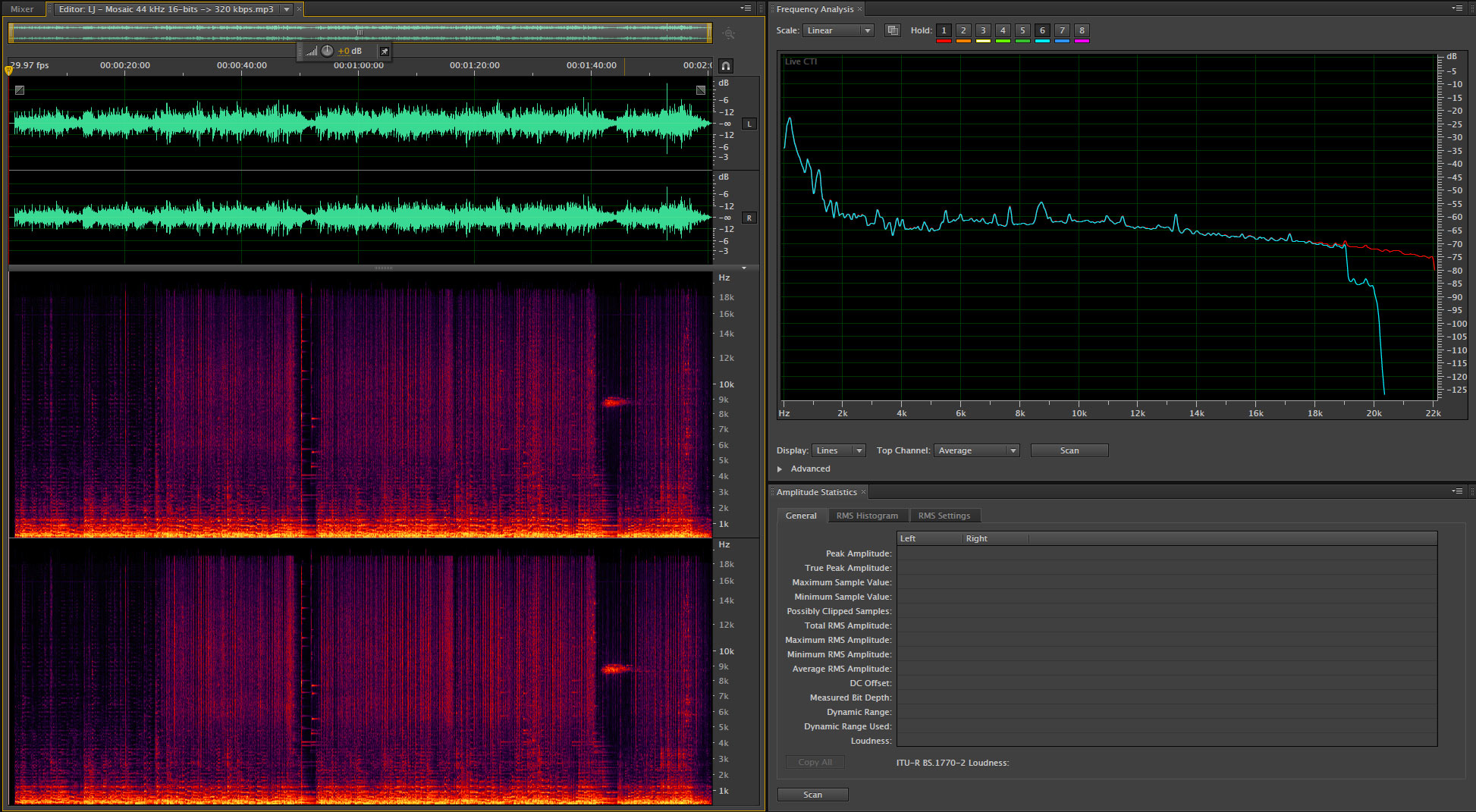Comparing a 320 kbps MP3 files and Redbook CD
Do you think the masses can tell the difference between CD standard fidelity and a “lossy” compressed MP3 file at 320 kbps? Or that they care? Do you think that you can tell the difference? It is becoming obvious that downloaded or streaming music is going to max out at CD quality. And that’s OK with me. We can talk all day long about 16-bits vs. 24-bits and the benefits of ultrasonic frequencies on DVD-Audio or Blu-ray Pure Audio discs, but the reality is that Sonos, Pono, WMiP, Tidal, and Deezer have adopted standard resolution CD “Redbook” spec as their fidelity of choice. I applaud them all for moving us away from the decidedly “reduced resolution” of HD Radio, 128 kbps MP3s, and other compromised audio delivery formats. And maybe they’ve got it right…from a business point of view.
But how do you think a very high bitrate MP3 files would fare against a CD track?
My recordings and the iTrax.com download site opted to sell real HD-Audio in 2007 and I’ve maintained that standard ever since. Others have decided to redefine the meaning of high-resolution so that 35 million tracks can be reclassified as HD and sold again in an uncompressed format. But in reality, are the masses going to flock to files that are much larger and more expensive when there is very little difference between a CD spec audio file and a well-recorded MP3 at 320 kbps? I don’t think so.
I’ve taken my award-winning track “Mosaic” and placed it in a folder on the FTP (you can get access to the FTP credentials by clicking here) as an MP3 file at 320 kbps and in standard CD resolution. You can download them and see if you can tell the difference. Survey your friends and see if they notice a difference. My guess is that they won’t be able to. Certainly not through ear buds or even a cheap set of phones.
Here’s “Mosaic” in both formats by the numbers:
Figure 1 – The numbers for “Mosaic” [Click to enlarge]
The MP3 file is less than a quarter the size of the uncompressed CD spec version. And the only specification change is the loss of the extreme high-end frequency response in the MP3 file. The MP3 extends to 18 kHz before dropping dramatically while the CD version maxes out at the Nyquist Frequency. The dynamic range dips slightly as well.
Here’s the spectrogram for both of the versions:
Figure 2 – The spectra of the 320 kbps MP3 version of “Mosaic” [Click to enlarge]
Figure 3 – The spectra of the Redbook CD version of “Mosaic” [Click to enlarge]
As much of an advocate for real high-resolution audio as I am, I have to admit that sitting here at my desk with the air conditioning running and the cooling fans of my hard drives whirring in the background…I can’t tell them apart. They both sound great! And remember, I haven’t even included the real HD-Audio version…the one at 96 kHz/24-bits (which is also on the FTP site for those that haven’t yet heard it).
Maybe Apple is right. I can imagine a meeting between Tim Cook and Tomlinson Holman in Tom’s lab at Apple where they do this very comparison. If you were the CEO of Apple, would you add high-resolution audio capabilities to the new iPhones?





My response as Apple CEO: Definitely NOT!!!! HRA (24-96 and above) is for High-End audiophiles with equipment that can extract the very small nuances of recorded music and with dynamic response that exceeds at least 120dB. And I am talking uniquely of original digital master recordings that at ALL recording process maintain at least the 24dB-96KHz resolution. So, if you will maintain your HRA recordings with no down conversions it is better to modify immediately their identification names to UHRA (Ultra High Resolution Audio) as you suggested previously to differentiate them from the plethora of recordings falsely named HRA that will flood the market after next October.
I agree. I don’t think most folks will pay more for HD music that they can’t distinguish from their MP3s (due to poor engineering, up-sampling from CD quality, lack of sufficient playback equipment, or 50-some-year-old ears that can’t hear above 12 kHz, like mine). Some might pay for CD-quality. Most will be happy with high-rate MP3.
So, I think these businesses, like HDTracks, NativeDSD, etc., will fail because there’s no value for the additional price.
Instead of focusing on high bit-rates, such companies should differentiate based on something people can actually perceive: surround sound. If I could download well-engineered 5.1 CD-quality recordings of my favorite artists, that’s something I would pay for.
I know you offer that, and I have bought 5.1 music from itrax.com, which I very much appreciate.
I think you need to take your marketing message to the next level, though. Your message (web sites, blog, etc) focus too much on “HD music” and not enough on “surround music”. Even your sample downloads are mostly stereo. There’s only one multi-channel file in the sample set. Boo.
I think that’s the real opportunity for the music business–surround music downloads (at CD quality, with better engineering). Forget the 24/96 stereo stuff.
So change the message. Drop realhd-audio.com, start surround-audio.com (or something similar). Change the message on the front-page on itrax. Make it easy to filter the product search for multi-channel. Partner with hardware vendors providing playback of 5.1 FLAC files (surprisingly difficult to find!). Target home theater owners, not audiophiles (who seem hung-up on stereo, for reasons I can’t fathom).
And, of course, keep up the great work you’ve done with provenance and better recording engineering!
You’re right that surround is a much easier sell..until you start talking about the extra speakers etc.
Well, sure. That’s why I say to re-target your market. Home theater users already have the 5 speakers. Plus there are a lot more home theater people than there are audiophiles (and their two-channel systems). Bigger market, easier sell. It’s a no-brainer.
Ken,
I totally agree! I read today’s blog from Mark and he sounded a little discouraged. The Red Book CD specification, if fully implemented, would, for easy listening (back ground stuff,) be really quite acceptable. Trouble is: MP3 convenience (with its lossy format) has ruled the audio world for several years already. MP3 is a garbage format alright. Much lower than the Red Book CD specs!
Second trouble is: Mark is trying to get the recording industry to recognize and accept a definition for High Resolution Audio much above the CD specs. That is a BIG step up from MP3 quality. Most promoters today want to call their CD versions, “high definition”, when it is only a somewhat higher level of definition. Back to CD levels from MP3 level is in the right direction, but not enough for audiophiles. I think that most people are satisfied with CD specs because they do not have discriminating listening habits, or want music for background fillers only, or have auditory limitations and can’t hear the differences any way.
What’s going on with HRA is a wonderful opportunity for advancement in the audio improvement cause. But just how far it will go will be interesting to participate in. My cynical self recognizes that the BIG players in the recording industry need BIG payoff, or they won’t invest. And if the masses don’t demand HRA or don’t put their money onto the sales counter, HRA will remain a niche market. Or worse yet, suffer a demise just like DVD-Audio and SACD did.
Dad.
Listen to the files (“Mosaic” is an award-winning track)…they are virtually identical until the last part of the upper frequency range. The real question is will this matter to the masses? I doubt it.
This is a very interesting dialog. I have had this debate with many for 15 plus years. I think one’s capability to tell the difference between the formats – lay NOT in the format – but in the original Master tape/ disc – source – ( what have you ) and the way it was mix and recorded – and in what type of gear one has to play the recording back on. ( aka – type of cd player, amp – and speakers one has 9 not to mention listening environment .Trust me – I can tell the difference. Of course this article is discussing HQ 320kbps files- and truth be told – so many don’t even use that data rate – but either 256, 192 – or my God- even less ( as s many streaming services and XM radio do ) which is sad. Even with a nice 256 file – on an older recording – like say -some CCR songs – or Simon & the other guy who’s name I can’t spell- i can hear a big difference in the recording quality – in both the drum kits and any string instrument. As far as SACD goes – I have both the remastered ad multi-channel 30th Ann. SACD version of Pink Floyd’s Dark side of the Moon. The two Ch Stereo version seems outdated by comparison to the multi channel version – and what they were trying to a accomplish. I think the problem SACD had was so many people justdon’t care anymore about listening to music at home on Hi-fi system. My old test sysem for 2chreproduction consisted of a intergrated amp, along with a Technics SL-7 turntable, a Sony SBM CD player /recorder, a Sony SACD player, and a pair of Paradigm Export Studio Monitors. All kids know today is cheap sound bars and home theatre in a box (HTIAB) low powered systems Even the separate multi-channel receiver sold by Best Buy are all low powered jobbers. Why – people don’t know – and don’t care about music reproduction in the home. ( as their systems are all aimed at DVD playback – NOT Red book CD, SACD, and turntable playback. it’s all about portability today. I personally still use my Laserdisc player to transferr the Red Book CD LPCM soundtracks to CD. Yeah baby !
Can they hear the difference, I think most can. But they must have equipment capable of resolving the difference and most just don’t. High end is a Bose radio or their cellphone-ipod + ear buds.
Do they care, I don’t think so. For 40+ years I would set friends down in front of my system and point out the imaging and depth, the detail in the instruments, etc. Did even one of them go home and reposition their speakers to obtain a stereo image, not. one that I can remember. And this wouldn’t have cost them a cent. So NO, I don’t believe one in ten thousand give a rats behind about quality. HiFi as we used to call it.
Hi Dr. AIX. I download stuff from NPR or stream it and record the audio on another computer and burn it to a CD almost every week for years. If I really like the music, I buy the “real” CD. In comparing the 320k Mp3 with the commercial CD, I always hear more depth and fine detail on the commercial CD. But the difference shows up only on the “big” system. I’m a serious audiophile and the big rig is very nice. In the car or on a “computer audio desktop” system, the difference is hard to hear. With over $150 headphones (Sony, KEF, Stax), the difference is apparent; but if you’re also watching a ball game or reading the mail, the difference is minor. CASUAL LISTENING – NO DIFFERENCE. Serious listening on good gear – CDs beat any MP3s.
Best Wishes, Boomer Bill
I wish Apple would add the capability and give us a choice instead of forcing lossy audio onto us. The iPhone 6 certainly has the specs to play HD audio. Apple has never been a big advocate of choice. Recently, Apple’s been adding more options like hardware colors and a few more settings options, but it’s mainly to placate customers because of the growth in consumers wanting more options. While a step in the right direction, the additions are mainly superficial. I am glad Apple finally added NFC. They should have added it a long time ago, but they didn’t add it so people could quickly pair devices. They only added it so they could make .15% on every transaction from Apple Pay. If Apple Pay didn’t exist, the phone still wouldn’t have NFC.
Hi Mark
I did an experiment a few years ago in which I compared 320 kbs MP3s with CDs. My listening was to hundreds of pieces/songs, and I used Sennheiser HD-600 headphones for all comparisons. Try as I might, on 99% of music I listened to, I could tell no difference. (On the other hand, bitrates lower than 320 kbs just don’t make the grade.) If there were cymbals or high-density orchestral climaxes, I could perceive a difference, but it that was it. Most music sounded exactly the same to me.
You also mentioned Sonos in this post and in a previous one. I have had Sonos as a streamer for several years and it is quite satisfactory to me. It’s interface is very good and I love being able to instantly find what I want to hear. When I have hi-rez files, say 24/96, I make copies downconverted to 16/48 so they are available through the Sonos network. The Sonos box in my primary listening area goes through an asynchronous sample rate converter/reclocker from Empirical Audio that dramatically improves its sound, or at least serves nicely as a placebo to make me think so. I have seen recently that Sonos is finally looking for a way to offer 24/96, and, when that happens, it will be interesting to compare the higher-rez files with the 16/44 ones from the same source, and I will be using only true hi-rez files (like yours) for the comparison. Personally, I don’t expect to hear a radical difference—I am quite satisfied with the sound I am getting from CD-quality on my current setup. I will try to keep an open mind, though.
I have to mention this—I think it is admirable that you, a producer of true hi-rez music, will say publicly that in a real-world environment you couldn’t notice a difference between files of different resolutions. I wish everyone were so honest. If we could solve the bigger audio problems like bad mastering and the loudness wars, almost everything that is well recorded could sound great. (I am ignoring the even bigger problem of untreated, bad-sounding rooms, a problem that dwarfs all arguments about resolution.) Then, if high-rez proves to be a huge improvement, people will flock to it, at least those with the equipment that can do it justice. I am trying not to prejudge, but I suspect that the high-rez buzz is mainly a result of the record companies’ desire to sell us the same music for the third or fourth time. Only guys like you, who sell high-rez files that were originally recorded as such, will be able to make claims of superior sound.
Thank you for your superb postings and for your intellectual honesty.
Jim Livengood
What’s even more interesting is that if you used the best and latest version of an mp3 codec (LAME 3.99.5), you’d probably find that encoding to VBR V0 instead of CBR 320 would result in even better audio quality that would make it even tougher to distinguish from lossless. In version 3.99.5, there is no low pass filter on V0 but still is on CBR 320, so the high frequency tells will likely disappear. Many think that VBR V0 (about 250kbs) is better than CBR 320bps for this reason as well as better overall tuning of the VBR algorithm, even though VBR V0 is more compressed.
The low pass filter will likely also be removed from CBR 320 in the next version of LAME that will apparently focus on tuning CBR, FWIW, whenever it comes out.
Interesting, I will have to look into this. Thanks
Dr AIX,
There is a new article by Charles Zeilig, Ph.D., and Jay Clawson in The Absolute Sound, October 2014, Issue 246, that addresses up-sampling and sound quality that I think is in your wheelhouse and you may find provocative and worthy of your comments.
On page 47 of the magazine, they state: “The results shown in Figure 2B illustrate the very significant and useful sonic improvement that can be achieved with up-sampling. Ripping CDs followed by up-sampling improves the original SQ [sound quality] and provides enhanced value to an existing CD collection.”
They also say the following regarding their positive up-sampling findings: “…..some justification for commercial claims that up-sampling produces a better SQ akin but not equal to true high-resolution recordings. ”
Do you know who these two gentlemen are?
Phil C
I haven’t seen the article yet but will see if I can find my copy of TAS. My initial reaction is that it’s impossible to get back the quality or fidelity that would be present in a native High Resolution audio file through upsampling…but I’ll withhold judgement under I see the article. I don’t know these guys personally but have read some of their previous writings.
I took the Mosaic test. First, I used inexpensive playback with a laptop/iTunes connected to an iHome external speaker through the laptop’s analog mic output. I couldn’t hear differences between the three music files.
Then I listened through my high resolving system that includes a Benchmark DAC1 HDR and I could hear differences, especially between 320 kbps and 96/24 which sounded significantly better.
Phil C
I think you’ve identified the key aspect of listening. Your system matters a great deal. I’m not sure about the “laptops’s analog mic output” hooked up to the iHome external speaker.
Remember, though, that MP3 is designed to MAXIMISE the MEASURED difference between the before and after files. The clever bit is to have the difference masked to the point of inaudibility by the psychoacoustics of listening.
Therefore, the whole idea of measuring the difference is a mistaken avenue of investigation. The ONLY valid way to assess the success of an MP3 codec is blind listening tests.
Grant, I’m taking your comment to mean that MP3 is trying to maximize the difference in terms of bandwidth and storage size, while attempting to maintain as much of the original fidelity. The psychoacoustic method of masking and data redundancy work really well. The two example I posted are virtually identical by their specs and do sound remarkably close in fidelity.